The movie The Sound of Music is beloved by many, a classic tale of music, love, and escape from Nazi-occupied Austria. For generations, the story of Maria and The Von Trapp Family has captivated audiences worldwide. But how much of the Hollywood version aligns with the real life of the von Trapp family singers? As an archivist and historian, I’ve often been asked about the true story behind the cinematic legend. Like many, my first encounter with the von Trapps was through the film, and while charmed, my historical senses tingled with questions about its accuracy. Years later, delving into primary sources, including documents from the National Archives, revealed a richer, more nuanced story than the movie portrays. The real von Trapp family’s journey is filled with complexities, challenges, and triumphs that are even more compelling than the fictionalized account. Let’s explore the facts versus the fiction and uncover the real story of the von Trapp family.
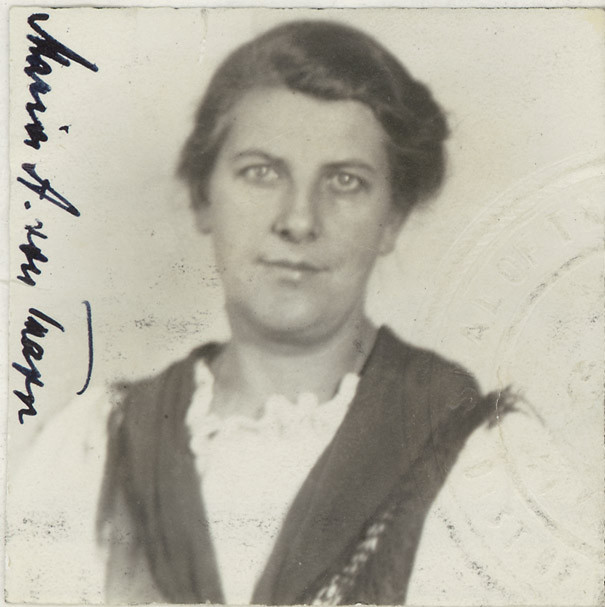 Maria von Trapp smiles warmly, photographed for her US citizenship application in 1944.
Maria von Trapp smiles warmly, photographed for her US citizenship application in 1944.
Fact vs. Fiction: Unpacking The Sound of Music
While The Sound of Music draws inspiration from Maria von Trapp’s book, The Story of the Trapp Family Singers, the movie takes significant liberties with the truth. These changes, while enhancing the dramatic narrative for the screen, often misrepresent key aspects of the von Trapp family’s actual experiences.
-
The Tutor, Not the Governess: In reality, Maria arrived at the von Trapp household in 1926 not as a governess for all the children, but specifically as a tutor for Maria, one of Captain von Trapp’s daughters, who was recovering from scarlet fever. The movie simplifies this by depicting her as a governess to all seven children.
-
Marriage Timeline: Maria and Georg von Trapp were married in 1927, a full eleven years before their departure from Austria, not in the immediate lead-up to the Nazi annexation as the film suggests. This alteration in the movie heightens the romantic tension and compresses the timeline for dramatic effect.
-
A Marriage of Children, Then Love: The movie portrays a blossoming romance between Maria and Captain von Trapp. However, Maria’s autobiography, Maria, reveals a different motivation for their marriage. She confessed to falling in love with the children first. When Georg proposed, she wrestled with abandoning her religious calling but was encouraged by nuns to see it as God’s will. Her words reveal a marriage that began not with romantic love for Georg, but with a deep affection for his children, with love for Georg growing over time. “I really and truly was not in love. I liked him but didn’t love him. However, I loved the children, so in a way I really married the children. . . . [B]y and by I learned to love him more than I have ever loved before or after.”
-
Ten Children, Not Seven: The von Trapp family was larger than depicted in the movie. They had ten children in total, not seven. The film simplifies the family size, likely for narrative convenience.
-
Names and Ages Recast: The names, ages, and genders of the children were changed for The Sound of Music. This fictionalization further distances the movie from the actual family members.
-
Musicality Before Maria: The movie implies the children’s musical talent was awakened by Maria. In truth, the von Trapp family was already musically inclined before Maria’s arrival. However, she did introduce them to madrigals, expanding their repertoire and musical skills.
-
Captain von Trapp’s True Nature: The film initially presents Captain von Trapp as a stern, music-averse patriarch, contrasting sharply with the warm and musical Maria. This portrayal is a significant departure from reality. Those who knew him, including his children, described Georg von Trapp as a gentle and warm-hearted father who actively enjoyed music with his family. This fictional coldness was added to create a more compelling character arc and highlight Maria’s positive influence, but it deeply upset the real von Trapp family.
-
Escape Route Revision: The iconic scene of the von Trapps dramatically escaping over the Alps to Switzerland with suitcases and instruments is pure Hollywood fiction. Daughter Maria, in a 2003 Opera News interview, clarified, “We did tell people that we were going to America to sing. And we did not climb over mountains with all our heavy suitcases and instruments. We left by train, pretending nothing.” The dramatic mountain escape is a powerful cinematic moment but bears no resemblance to their actual departure.
-
Destination Italy, Not Switzerland: The family’s escape route wasn’t to Switzerland, but to Italy. Georg von Trapp was born in Zadar, which was then part of the Austro-Hungarian Empire and later became part of Italy. This Italian citizenship allowed the family to travel to Italy by train. From Italy, they contacted their American booking agent to arrange passage to the United States.
-
The Real Musical Director: The movie features Max Detweiler, a fictional, opportunistic music promoter. In reality, their musical director for over two decades was their priest, Reverend Franz Wasner. He played a significant role in their musical journey, a role fictionalized for the movie.
-
Maria’s Temperament: Julie Andrews portrays Maria as unfailingly sweet and gentle. The real Maria, while loving and caring, also had a fiery temper. She was known to have outbursts of yelling, throwing things, and slamming doors. However, these outbursts were often short-lived, with her good humor quickly returning. Other family members, particularly her husband, found it harder to recover from these displays. Her daughter Maria acknowledged in a 2003 interview, “she had a terrible temper. . . . And from one moment to the next, you didn’t know what hit her. We were not used to this. But we took it like a thunderstorm that would pass, because the next minute she could be very nice.” This human complexity is softened in the movie’s portrayal.
The Real Von Trapps: A Story Beyond the Silver Screen
Georg von Trapp, born in 1880, was a decorated Austrian naval hero. As a captain during World War I, he commanded submarines with distinction, earning the title “Ritter” (knight), later elevated to baron, for his bravery. In 1912, he married Agathe Whitehead, granddaughter of Robert Whitehead, the inventor of the torpedo. Together, they had seven children: Rupert, Agathe, Maria, Werner, Hedwig, Johanna, and Martina.
 Agathe, Joanna, Erwina, and Gobertina von Trapp are listed in a historical document, showcasing their full names.
Agathe, Joanna, Erwina, and Gobertina von Trapp are listed in a historical document, showcasing their full names.
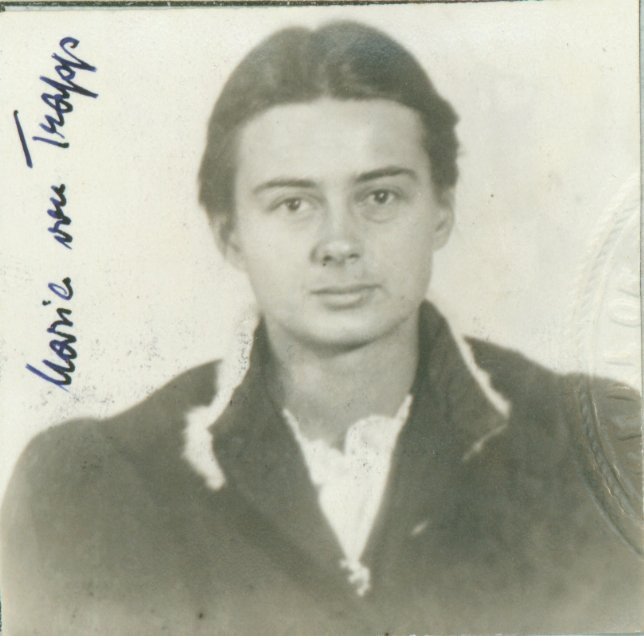 Maria Agatha Franzisca Gobertina von Trapp's name is clearly recorded in archival records.
Maria Agatha Franzisca Gobertina von Trapp's name is clearly recorded in archival records.
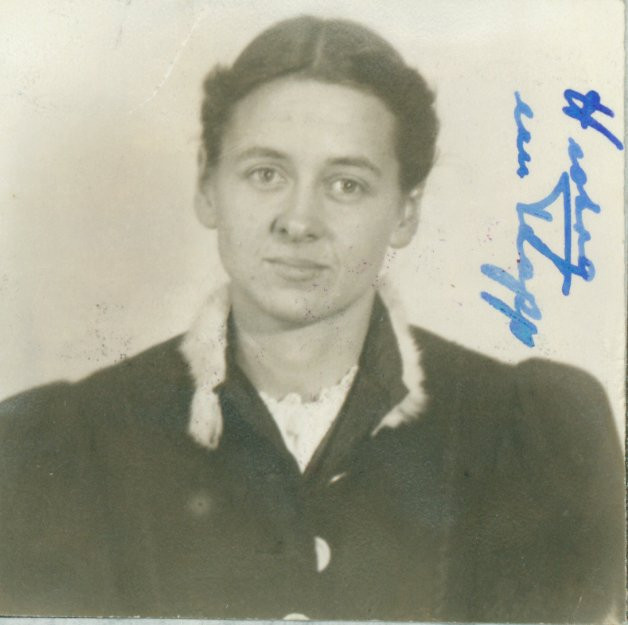 Hedwig Maria Adolphine Gobertina von Trapp's full name appears on official documents, preserving her identity.
Hedwig Maria Adolphine Gobertina von Trapp's full name appears on official documents, preserving her identity.
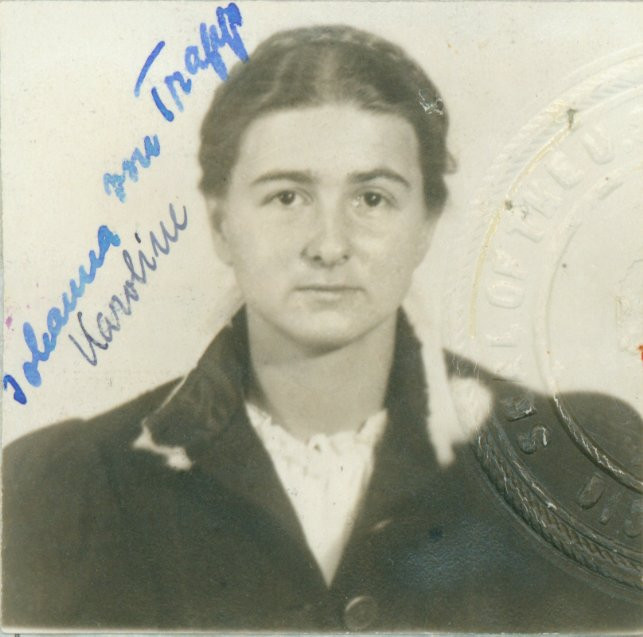 Johanna Karoline von Trapp's name is documented, a testament to her place in history.
Johanna Karoline von Trapp's name is documented, a testament to her place in history.
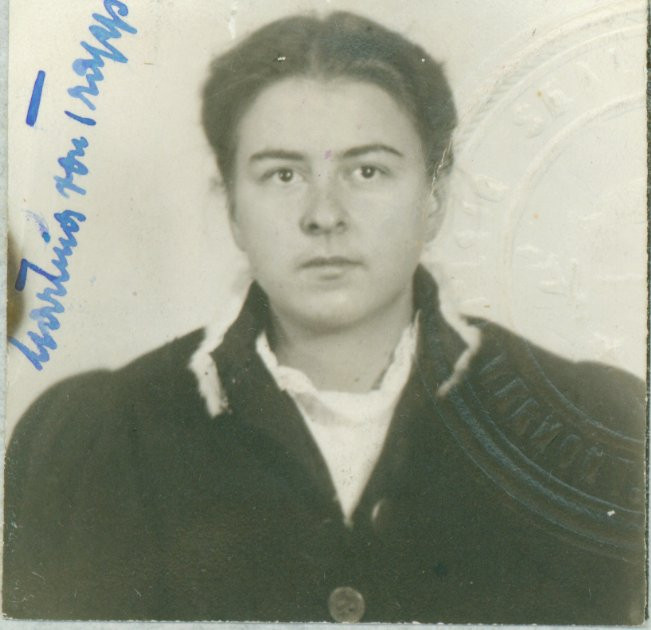 Martina von Trapp's name is visible in historical archives, ensuring her story is remembered.
Martina von Trapp's name is visible in historical archives, ensuring her story is remembered.
After Austria lost its seaports following World War I, Georg retired from the navy. Tragedy struck in 1922 when Agathe died of scarlet fever, leaving the family heartbroken. Seeking a fresh start, Georg sold their property in Pola and purchased an estate in Salzburg.
Maria Augusta Kutschera was born in Vienna in 1905. Orphaned young, she was raised in an atheistic and socialist environment by a relative she described as abusive. A pivotal moment occurred while she was studying at the State Teachers’ College of Progressive Education in Vienna. Mistaking a Palm Sunday service for a Bach concert, she attended and was profoundly moved by the priest’s sermon. Despite her upbringing that dismissed biblical stories as myths, she was captivated. “Now I had heard from my uncle that all of these Bible stories were inventions and old legends, and that there wasn’t a word of truth in them. But the way this man talked just swept me off my feet. I was completely overwhelmed,” she wrote in her autobiography, Maria. This experience led to a religious awakening, and after graduating, she entered the Benedictine Abbey of Nonnberg in Salzburg as a novice. While the strict rules were challenging, she felt it was a necessary period of personal growth, “These . . . two years were really necessary to get my twisted character and my overgrown self-will cut down to size.”
However, the abbey’s enclosed life affected her health. When Georg von Trapp requested a tutor for his ailing daughter Maria from the Abbey, Maria Kutschera was chosen. Her teaching skills and the need for her to have more fresh air made her a suitable candidate. Initially intended to stay for ten months before fully committing to the convent, Maria’s time with the von Trapp family took an unexpected turn.
Maria connected deeply with all the children, tutoring young Maria, singing with them, and introducing them to outdoor activities. During this period, Georg fell in love with Maria and proposed marriage, asking her to stay and become a mother to his children. Maria, uncertain but guided by her faith, accepted. “God must have made him word it that way because if he had only asked me to marry him I might not have said yes,” she reflected on his proposal. Maria Kutschera and Georg von Trapp married in 1927 and went on to have three more children: Rosmarie, Eleonore, and Johannes.
The Great Depression in the early 1930s brought financial hardship when their bank failed. Maria took charge, dismissing most of the servants and taking in boarders to make ends meet. It was during this time that the family’s singing hobby began to be considered as a profession. Georg initially hesitated, uncomfortable with public performance, but eventually accepted it as “God’s will.” Despite his reservations, as daughter Eleonore recounted in a 1978 Washington Post interview, “It almost hurt him to have his family onstage, not from a snobbish view, but more from a protective one.” As depicted, albeit loosely, in The Sound of Music, the von Trapp Family Singers won first prize at the Salzburg Music Festival in 1936, launching their successful career touring Europe, performing Renaissance and Baroque music, madrigals, and folk songs.
The Nazi annexation of Austria in 1938 cast a dark shadow over the von Trapp family. Opposed to the Nazi regime, Georg refused to fly the Nazi flag and declined both a naval command and an invitation to sing at Hitler’s birthday celebration. The family grew increasingly concerned about Nazi propaganda, anti-religious policies, and the atmosphere of fear and suspicion. Faced with the choice of staying and accepting Nazi compromises – potential fame, a doctor’s position for Rupert, and naval opportunities for Georg – or leaving behind their home and possessions, they chose principle over comfort. They decided to flee.
 The first page of the SS Bergensfjord passenger list from 1939, clearly showing the von Trapp family's names listed.
The first page of the SS Bergensfjord passenger list from 1939, clearly showing the von Trapp family's names listed.
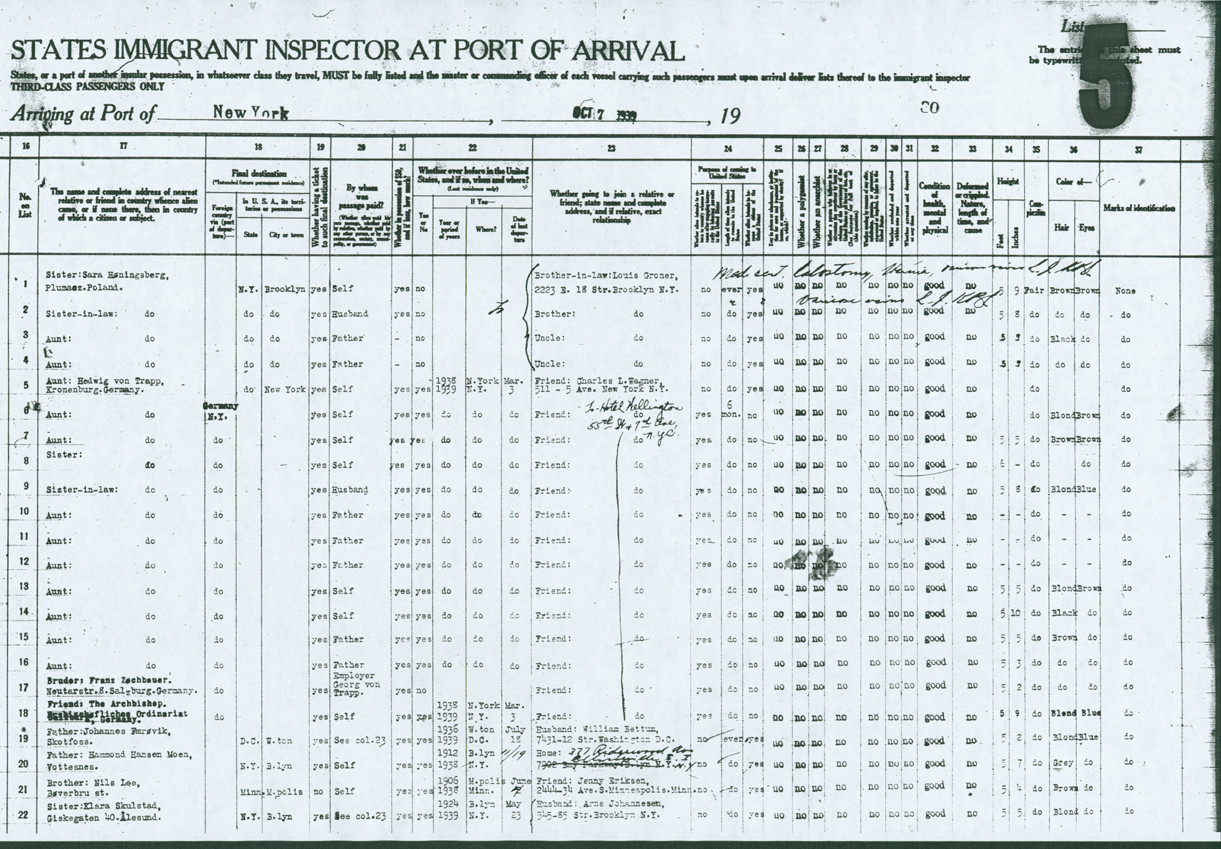 Page two of the SS Bergensfjord passenger manifest, continuing the list of passengers aboard the ship to America.
Page two of the SS Bergensfjord passenger manifest, continuing the list of passengers aboard the ship to America.
Accompanied by their musical director, Reverend Wasner, and secretary, Martha Zochbauer, they traveled by train to Italy in June 1938, then to London, and by September, they were on a ship to New York, embarking on a concert tour in Pennsylvania. Their youngest son, Johannes, was born in Philadelphia in January 1939.
When their six-month visas neared expiration, they briefly toured Scandinavia before returning to New York in October 1939. Upon arrival, they were detained at Ellis Island for questioning by immigration officials. Maria’s enthusiastic declaration, “Oh, I am so glad to be here—I never want to leave again!” when asked about their intended stay, raised concerns as it contradicted the six-month visa limit. The Story of the Trapp Family Singers recounts their release after a few days, allowing them to continue their tour.
 A historical record from 1939 documenting aliens held for special inquiry, including information about the von Trapp family's case.
A historical record from 1939 documenting aliens held for special inquiry, including information about the von Trapp family's case.
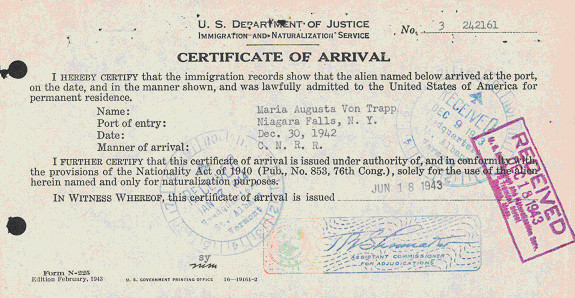 Maria von Trapp's Certificate of Arrival in Niagara Falls, NY, dated 1942, officially verifying her legal entry into the United States.
Maria von Trapp's Certificate of Arrival in Niagara Falls, NY, dated 1942, officially verifying her legal entry into the United States.
In the early 1940s, the von Trapps settled in Stowe, Vermont, purchasing a farm. They established a music camp on their property during their off-tour periods. In 1944, Maria and stepdaughters Johanna, Martina, Maria, Hedwig, and Agathe applied for U.S. citizenship in Vermont. Georg, it seems, never sought citizenship. Rupert and Werner became citizens while serving in the U.S. military during World War II. Rosmarie and Eleonore derived citizenship through their mother, and Johannes, born in the U.S., was a citizen by birthright.
Georg von Trapp passed away in 1947 and was laid to rest in the family cemetery on their Vermont property. The family members who applied for citizenship achieved it in 1948. The Trapp Family Lodge, still operating today, opened its doors in 1950. Despite continued success, the Trapp Family Singers ceased touring in 1955. By this time, many of the von Trapp children wished to pursue other paths, and it was largely Maria’s determination that had sustained the group for so long.
In 1956, Maria, along with Johannes, Rosmarie, and daughter Maria, embarked on missionary work in New Guinea. Later, Maria managed the Trapp Family Lodge for many years. The von Trapp children pursued diverse paths: Rupert became a doctor; Agathe, a kindergarten teacher; Maria, a missionary for three decades; Werner, a farmer; Hedwig, a music teacher; Johanna married and returned to Austria; Martina passed away in childbirth; Rosmarie and Eleonore remained in Vermont; and Johannes managed the Trapp Family Lodge. Maria died in 1987 and was buried beside Georg and Martina.
The Von Trapps and The Sound of Music: A Complicated Legacy
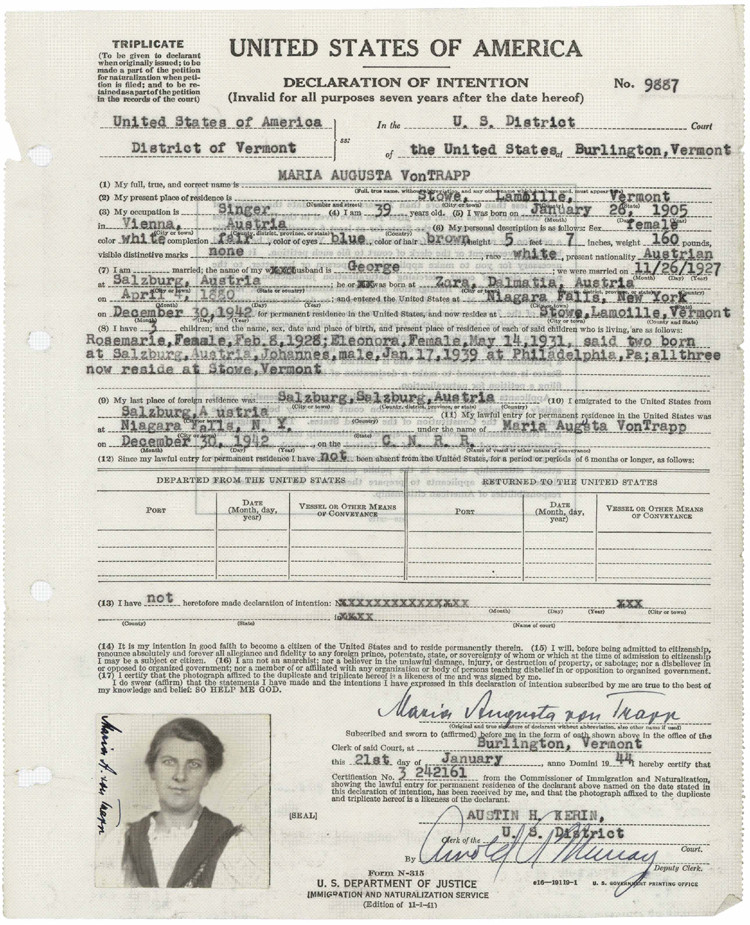 Maria von Trapp's Declaration of Intention to become a US citizen, signed and dated as part of her naturalization process.
Maria von Trapp's Declaration of Intention to become a US citizen, signed and dated as part of her naturalization process.
Ironically, the von Trapp family saw little of the immense profits generated by The Sound of Music. Maria had sold the film rights to German producers, inadvertently relinquishing her rights in the process. The German films, Die Trapp-Familie (1956) and Die Trapp-Familie in Amerika (1958), were successful in their own right. When American rights were acquired, the family had minimal involvement in the stage play or movie adaptations of The Sound of Music. While the play’s producers listened to some of Maria’s suggestions as a courtesy, none were substantially incorporated.
The von Trapp family held mixed feelings about The Sound of Music. Maria was appreciative that her original story in The Story of the Trapp Family Singers wasn’t drastically altered and felt she was portrayed reasonably accurately, albeit with a softened, overly gentle image by actresses like Mary Martin and Julie Andrews. However, she was unhappy with the depiction of her husband. The children shared similar sentiments: annoyance at being portrayed as solely light music singers, the oversimplification of their story, and the misrepresentation of their father’s personality. Johannes von Trapp, in a 1998 New York Times interview, expressed his feelings, “it’s not what my family was about. . . . [We were] about good taste, culture, all these wonderful upper-class standards that people make fun of in movies like ‘Titanic.’ We’re about environmental sensitivity, artistic sensitivity. ‘Sound of Music’ simplifies everything. I think perhaps reality is at the same time less glamorous but more interesting than the myth.”
Exploring historical records allows us to distinguish between the romanticized fiction and the complex reality of the von Trapp family’s life. Researching this article, drawing on Maria von Trapp’s books, contemporary news reports, and original documents, illuminated the significant differences between their real experiences and the fictional narratives. My initial glimpse of Maria on Dinah Shore’s show hinted at a deeper story. The von Trapps’ true story, like those of many, is a testament to the fact that real lives are often more captivating than any fictional tale.
The von Trapp family’s immigrant experience, documented in the National Archives, is just one of countless American stories found within census records, naturalization papers, court documents, and more. Their journey, though famous, echoes the experiences of many who have sought new lives and opportunities in America.
Joan Gearin, an archivist at the National Archives and Records Administration, Northeast Region–Boston.
Note on Sources:
The National Archives and Records Administration, Northeast Region–Boston in Waltham, Massachusetts, holds original naturalization records for the von Trapp family. Passenger arrival lists and records of aliens held for special inquiry are also available in National Archives locations.
 Maria von Trapp's petition for US citizenship, page one, displaying her formal application.
Maria von Trapp's petition for US citizenship, page one, displaying her formal application.
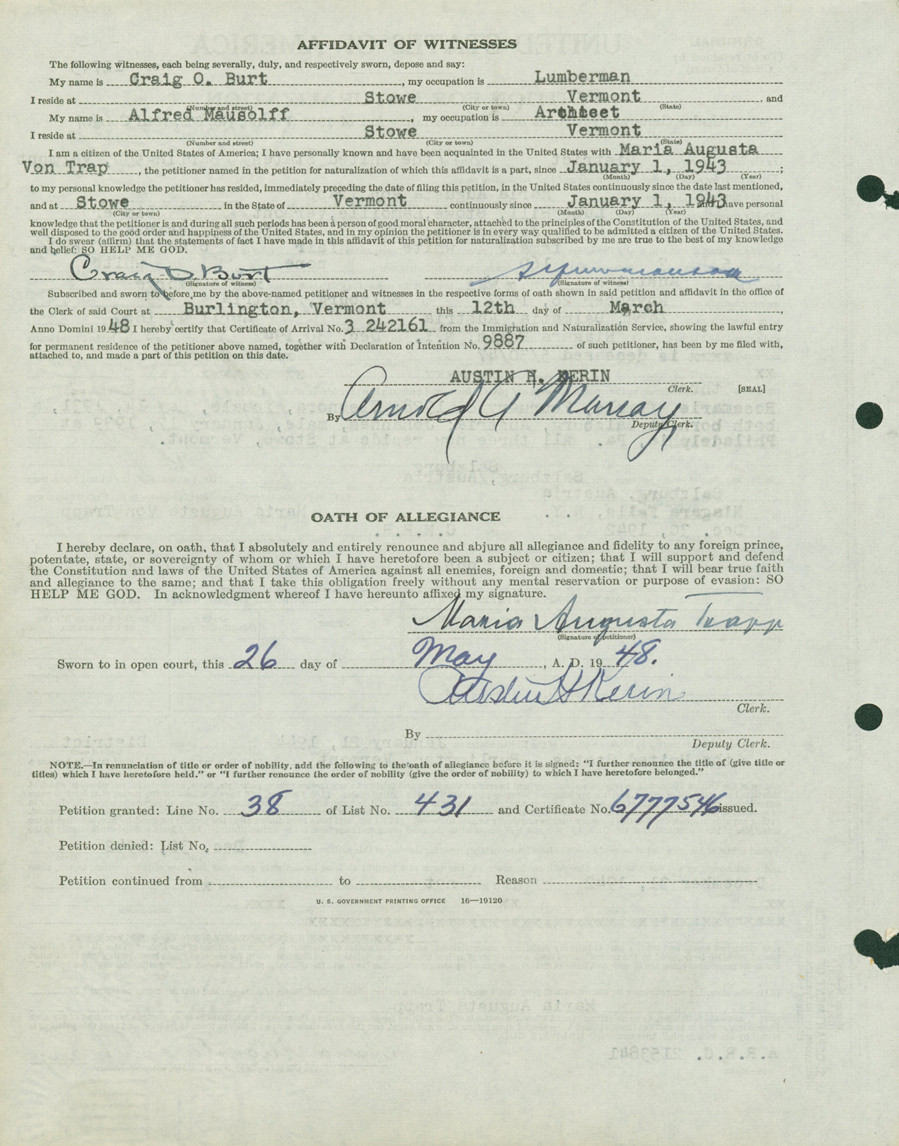 The reverse side of Maria von Trapp's citizenship petition, page two, with additional details and official stamps.
The reverse side of Maria von Trapp's citizenship petition, page two, with additional details and official stamps.
For firsthand accounts, consult Maria von Trapp’s The Story of the Trapp Family Singers and her autobiography Maria. Interviews cited include The Washington Post (1978), The New York Times (1998), and Opera News (2003).
[Updates with corrected and added death years of family members and clarification on Georg von Trapp’s title.]
Prologue articles do not necessarily reflect the views of NARA or the U.S. Government.
